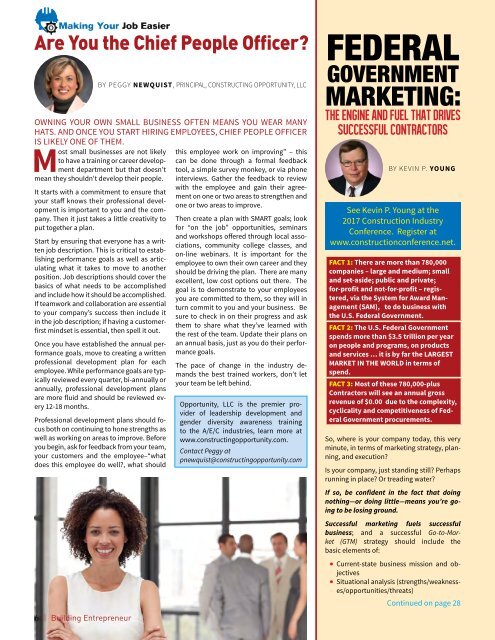Final Summer Issue to Print
Summer 2017 Building Entrepreneur Magazine
Summer 2017 Building Entrepreneur Magazine
Create successful ePaper yourself
Turn your PDF publications into a flip-book with our unique Google optimized e-Paper software.
Are You the Chief People Officer?<br />
BY PEGGY NEWQUIST, PRINCIPAL, CONSTRUCTING OPPORTUNITY, LLC<br />
OWNING YOUR OWN SMALL BUSINESS OFTEN MEANS YOU WEAR MANY<br />
HATS. AND ONCE YOU START HIRING EMPLOYEES, CHIEF PEOPLE OFFICER<br />
IS LIKELY ONE OF THEM.<br />
Most small businesses are not likely<br />
<strong>to</strong> have a training or career development<br />
department but that doesn’t<br />
mean they shouldn't develop their people.<br />
It starts with a commitment <strong>to</strong> ensure that<br />
your staff knows their professional development<br />
is important <strong>to</strong> you and the company.<br />
Then it just takes a little creativity <strong>to</strong><br />
put <strong>to</strong>gether a plan.<br />
Start by ensuring that everyone has a written<br />
job description. This is critical <strong>to</strong> establishing<br />
performance goals as well as articulating<br />
what it takes <strong>to</strong> move <strong>to</strong> another<br />
position. Job descriptions should cover the<br />
basics of what needs <strong>to</strong> be accomplished<br />
and include how it should be accomplished.<br />
If teamwork and collaboration are essential<br />
<strong>to</strong> your company’s success then include it<br />
in the job description; if having a cus<strong>to</strong>merfirst<br />
mindset is essential, then spell it out.<br />
Once you have established the annual performance<br />
goals, move <strong>to</strong> creating a written<br />
professional development plan for each<br />
employee. While performance goals are typically<br />
reviewed every quarter, bi-annually or<br />
annually, professional development plans<br />
are more fluid and should be reviewed every<br />
12-18 months.<br />
Professional development plans should focus<br />
both on continuing <strong>to</strong> hone strengths as<br />
well as working on areas <strong>to</strong> improve. Before<br />
you begin, ask for feedback from your team,<br />
your cus<strong>to</strong>mers and the employee–“what<br />
does this employee do well?, what should<br />
this employee work on improving” – this<br />
can be done through a formal feedback<br />
<strong>to</strong>ol, a simple survey monkey, or via phone<br />
interviews. Gather the feedback <strong>to</strong> review<br />
with the employee and gain their agreement<br />
on one or two areas <strong>to</strong> strengthen and<br />
one or two areas <strong>to</strong> improve.<br />
Then create a plan with SMART goals; look<br />
for “on the job” opportunities, seminars<br />
and workshops offered through local associations,<br />
community college classes, and<br />
on-line webinars. It is important for the<br />
employee <strong>to</strong> own their own career and they<br />
should be driving the plan. There are many<br />
excellent, low cost options out there. The<br />
goal is <strong>to</strong> demonstrate <strong>to</strong> your employees<br />
you are committed <strong>to</strong> them, so they will in<br />
turn commit <strong>to</strong> you and your business. Be<br />
sure <strong>to</strong> check in on their progress and ask<br />
them <strong>to</strong> share what they’ve learned with<br />
the rest of the team. Update their plans on<br />
an annual basis, just as you do their performance<br />
goals.<br />
The pace of change in the industry demands<br />
the best trained workers, don’t let<br />
your team be left behind.<br />
Opportunity, LLC is the premier provider<br />
of leadership development and<br />
gender diversity awareness training<br />
<strong>to</strong> the A/E/C industries, learn more at<br />
www.constructingopportunity.com.<br />
Contact Peggy at<br />
pnewquist@constructingopportunity.com<br />
FEDERAL<br />
GOVERNMENT<br />
MARKETING:<br />
THE ENGINE AND FUEL THAT DRIVES<br />
SUCCESSFUL CONTRACTORS<br />
BY KEVIN P. YOUNG<br />
See Kevin P. Young at the<br />
2017 Construction Industry<br />
Conference. Register at<br />
www.constructionconference.net.<br />
FACT 1: There are more than 780,000<br />
companies – large and medium; small<br />
and set-aside; public and private;<br />
for-profit and not-for-profit – registered,<br />
via the System for Award Management<br />
(SAM), <strong>to</strong> do business with<br />
the U.S. Federal Government.<br />
FACT 2: The U.S. Federal Government<br />
spends more than $3.5 trillion per year<br />
on people and programs, on products<br />
and services … it is by far the LARGEST<br />
MARKET IN THE WORLD in terms of<br />
spend.<br />
FACT 3: Most of these 780,000-plus<br />
Contrac<strong>to</strong>rs will see an annual gross<br />
revenue of $0.00 due <strong>to</strong> the complexity,<br />
cyclicality and competitiveness of Federal<br />
Government procurements.<br />
So, where is your company <strong>to</strong>day, this very<br />
minute, in terms of marketing strategy, planning,<br />
and execution?<br />
Is your company, just standing still? Perhaps<br />
running in place? Or treading water?<br />
If so, be confident in the fact that doing<br />
nothing—or doing little—means you’re going<br />
<strong>to</strong> be losing ground.<br />
Successful marketing fuels successful<br />
business; and a successful Go-<strong>to</strong>-Market<br />
(GTM) strategy should include the<br />
basic elements of:<br />
• Current-state business mission and objectives<br />
• Situational analysis (strengths/weaknesses/opportunities/threats)<br />
Continued on page 28<br />
6 | Building Entrepreneur







